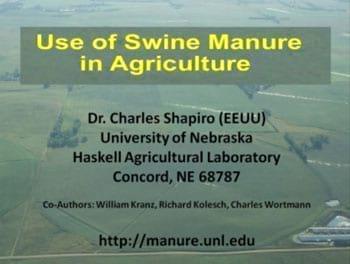Reducing Greenhouse Gas Emissions from Manure Storage
Published: November 18, 2008
Source : Prairie Swine Centre publication
Results and Discussion
• Nitrous Oxide and Surface Emissions
Surface emissions and emissions of nitrous oxide were found to be negligible in the first five weeks of sampling and further sampling was therefore discontinued. The nitrous oxide emission results were consistent with those previously measured at that site for the uncovered and straw covered EMB (Laguë et al. 2004).
• Seasonal emissions comparison
As expected, emissions increased as the ambient temperature increased through the summer months and continued into the fall. Higher temperatures promote biological activity, thus increasing emissions from the storage. Emissions were highest in the summer and fall months for uncovered and covered storages. Unlike the emissions from the uncovered and straw-covered surfaces, the carbon dioxide and methane emissions from the exhaust fans of the NAP cover were well correlated with each other and nearly equivalent during the spring and summer of 2004. This correlation may be explained by the controlled manner in which the NAP-covered gases are vented. Uncovered and straw-covered surfaces may release ‘burps’ of gas from time to time, skewing the emissions results, while the emissions from the NAP-cover must travel to the perimeter of the storage before being vented through the fans. During the fall, 2004, however, the methane emissions remained high while the carbon dioxide emissions decreased to typical fall emissions. In spring and summer, 2005, this trend continued as the methane emissions were two to three times higher than the carbon dioxide emissions. This may be attributed to the increased rainfall in 2005, increased solids content in the primary cell, or diff erent management strategies in the barn.
• Annual Emissions Comparison
In a previous study, Laguë et al. 2004 published the GHG emissions from uncovered and straw-covered EMB’s in Saskatchewan. In general, the straw cover reduced carbon dioxide and methane emissions by 57 and 85% respectively, compared to the uncovered surface (Figure 1). Nitrous oxide emissions were negligible in all cases. Using five seasons of emission data, the results show the NAP cover resulted in a 62 and 60% reduction in carbon dioxide and methane emissions respectively, compared to the uncovered surface. After one year of emission data (three seasons), the NAP cover efficiency was as high as the straw-cover at reducing CO2 and CH4 emissions.
Figure 1. Annual emissions from uncovered, straw-covered and NAP-covered EMB.

• Emissions comparison from the primary and secondary cells of the EMB
The study by Laguë et al. 2004 showed the secondary cell emissions were significantly higher than primary cell emissions for the uncovered storage while the primary cell emissions were higher than the secondary cell for the straw-covered EMB. For the NAP cover, except for the spring 2005 season, the primary cell had higher CO2 and CH4 emissions than the secondary cell. Secondary cell emissions were twice as high as those from the primary cell in spring, 2005. In the summer months, emissions from the primary cell were twice as high compared to those from the secondary cell.
• Emissions on Agitation Day (NAP cover)
The EMB at Elstow was agitated and emptied on September 28 and 29, 2004. The agitation system for the NAP cover includes pumping air through perforated tubes placed at the bottom of the primary cell to aerate and agitate the manure. The cover was pulled back to expose approximately one third of the surface of the manure, but the fans continued to operate to exhaust any gas that became trapped under the remaining cover. Pump-out and land application occurred during the second day.
Exhaust samples were drawn from the NAP fans of the primary cell once an hour during the second day. The GHG emissions on the pump-out day were equivalent to the maximum GHG emissions observed in the summer months prior to agitation (550 g of CO2-equivalent/m2-day for each gas). In the weeks after the agitation day, the CO2 emissions dropped to typical fall emissions. However, the CH4 emissions remained as high as the summer emissions and were two to three times higher than the CO2 emissions. This may be due to the ineffective agitation and suspension of the solid material, resulting in the higher solids content in the primary cell.
• Economic Evaluation of NAP and Straw Covers
The costs associated with the application of a straw cover include the cost of the bales, manual labour, equipment for application and the coverage provided by each bale which all depend on the size of the storage. The improved nitrogen retention means that the manure has a fertilizer value and costs associated with land application. The costs of the NAP cover include the capital cost of the system, some early maintenance and the annual cost to run the fans. The improved nitrogen retention means the manure has a higher fertilizer value and a higher cost associated with land application. Assuming average values for these variables ($12/bale, 70 m2/bale, 2.5 kg NH3-N/m3 retained in straw storage and 3.0 kg NH3-N/m3 retained in NAP storage, $0.85/kg N value and an application rate of 150 kg N/ha at a rate of $75/ha), the straw cover has an annual cost benefit of $10,151. Annualizing the capital cost of the NAP cover over the 10 year life expectancy means the NAP cover has an annual cost benefit of $5,845.
By J. Agnew, C. Laguë, É. Gaudet, J. Peterson, P. Loran, P. Rhodes, W. Burnett
Department of Agricultural and Bioresource Engineering, University of Saskatchewan
Prairie Swine Centre publication
Source
Prairie Swine Centre publicationRelated topics:
Recommend
Comment
Share

Would you like to discuss another topic? Create a new post to engage with experts in the community.





